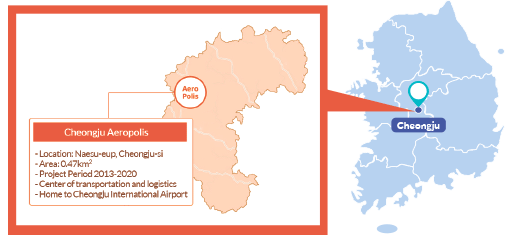
With the rapid growth of the
Cheongju International
Airport, the aviation indus
try has been increasingly
interested in Cheongju Aeropolis, the only
aviation industry cluster in the central
region of Korea.
The Cheongju International Airport has
seen significant growth in its number of
visitors, flights and international routes. It
has recently been designated by as an alter
nate airport for Code F aircrafts and a
Class II transport and logistics hub by the
government. As major airports in metro
politan areas are operating at full capacity,
the importance of the Cheongju Inter
national Airport is likely to grow even further.
Cheongju Aeropolis has access to airport
runway areas and the potential for explo
sive growth as the only aviation cluster in
the central region of Korea.
Cheongju is an inland city located just
128 km southeast of Seoul. Neighboring
cities like Daejeon and Cheonan, while just
a few hours away from Gwangju, Busan
and Jeju, Cheongju boasts some of the best
logistics in the country. In addition, its
well-established transport infrastructure,
including Cheongju International Airport,
KTX Osong Station and grid highways,
takes full advantage of the city’s location.
Also hailed as the ‘city of education’, the
region is home to six universities, includ
ing the Air Force Academy. Combined
with a robust industrial climate, optimal
research facilities and skilled workers, the
city is well equipped to open the gates to
Korea’s aerospace industry.

Designated in 2009 by the Ministry of Land, Infrastructure and Transport as
an
aircraft maintenance complex and in 2013
as part of the Chungbuk Free Economic
Zone (CBFEZ), the Cheongju Aeropolis is
set to lead Asia’s aerospace industry.
The 153,000 ㎡ aviation maintenance
complex (Aeropolis District One) and the
321,000 ㎡ aerospace industrial complex
(Aeropolis District Two) located through-
out Naesu-eup are made up of maintenance
facilities, parts production and assembly
facilities and an R&D center.
District One is the core of Aeropolis and
includes training and air flight/airport serv
ices. The cost estimate of this project is
KRW 45.2 billion (USD 40 million).
District Two focuses on businesses sup-
porting component repair and manufactur
ing and avionics. 13 companies have
signed MOUs agreeing to move some of
their operations there, potentially account
ing for 80 percent of the land available in
District Two. Furthermore, Aeropolis is
also a center for military aircraft develop
ment. It is the base of the Fighter Wing 17
and seeks to introduce 40 new fight-
er
planes by 2020.
The districts also house an aviation parts
logistics center, support facilities and the
Cheongju International Airport. In fact,
Aeropolis is currently accommodating
businesses specializing in aviation such as
RH Focus and Sungwoo Engineering.
The Cheongju Aeropolis also aims to
maximize economic synergy by building
hi-tech infrastructure to support the aero
space industry. Most notably, companies
can also take full advantage of its superb
ICT infrastructure, which centers on the
semiconductor industry, a key part of the
aircraft component sector. Furthermore, a
number of departments at the Korea
National University of Transportation
offers R&D support in the mechanical aircraft sector.
And thanks to its well-equipped R&D
infrastructure, the region is is effectively
converging technology and industry, fur
ther boosting Korea’s aerospace sector.